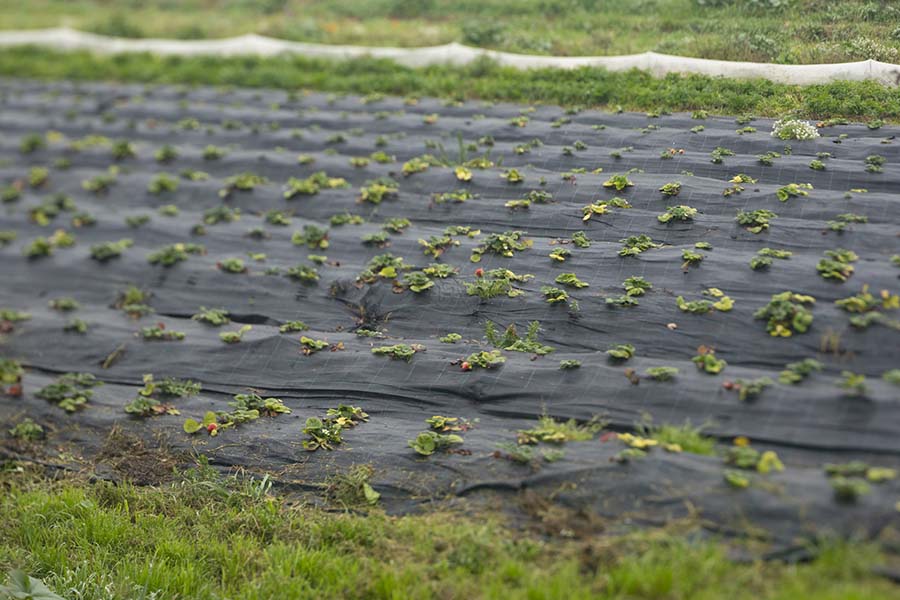Not That Felt Stuff: Introducing Slit-Film Woven Geotextiles
When you hear the term “landscape fabric” or “weed barrier,” you might immediately picture a roll of material that feels somewhat soft and fibrous, almost like thick felt. This type of fabric is known as nonwoven landscape fabric. It’s a common sight in garden centers and can be an affordable option for short-term weed suppression. To use a lumber analogy, you might compare it to chipboard: somewhat dense, made of random fibers bonded together, and relatively cheap, but it’s not particularly strong or resistant to environmental stresses.
However, the woven landscape fabric we focus on in this guide is a different beast altogether. First, it’s important to note that most geosynthetics sold by BTL Liners are geomembranes designed to be waterproof. In contrast, our slit-film woven geotextile is engineered with significant permeability for weed control, soil stabilization, and drainage applications.
Our slit-film woven landscape fabric is produced by weaving thin, flat strands of polypropylene together, similar to the cross-grained plies in plywood. This construction creates a material resistant to tears and distortion and provides uniform strength in all directions. You’ll likely see a clear pattern of interwoven lines. This distinct visual texture signals a stronger and more durable material than its nonwoven counterpart.
The slit-film geotextile is woven to leave tiny openings that allow water to filter through to the soil, which is essential for your plant’s health. It also provides a barrier against weeds and helps stabilize the soil. This fundamental difference in construction gives woven landscape fabric superior strength, durability, long-term weed control capabilities, and crucial permeability for healthy plant growth.
A Closer Look: What Does Woven Landscape Fabric Look and Feel Like
When you unroll a piece of quality woven landscape fabric, you’ll likely notice its distinct, almost grid-like pattern. At first glance, it might remind you of woven outdoor furniture fabric or a heavy-duty tarp. Individual strands, or threads, run in both directions and create a noticeable texture. The material often has a slightly slick or smooth feel, which contributes to its durability and resistance to tearing.
Pick up a piece of woven landscape fabric, and you’ll immediately recognize its strength. Unlike some delicate, nonwoven options, it resists stretching and doesn’t tear easily. While it’s flexible enough to conform to the contours of your garden beds or pathways, it has a substantial feel.
The Manufacturing Process (Simplified): How Durability is Woven In
The strength and durability of woven landscape fabric stem directly from its manufacturing process. It’s made from polypropylene resin, a type of plastic known for its durability and resistance to degradation from sunlight and chemicals. This resin is melted and extruded into thin, flat sheets. These films are slit lengthwise to create the individual flat strands that are the building blocks of the fabric.
Like traditional textiles, the tape strands are woven together on large looms. The woven structure secures the strands and creates a strong, stable mesh-like structure. This construction distributes stress across the entire fabric, making it highly resistant to damage from tears, punctures, and stretching. This inherent strength is key to woven landscape fabric’s ability to provide reliable, long-lasting weed control and soil stabilization in your garden.
Woven vs. Nonwoven: Understanding the Differences and Benefits for Weed Control and Durability
As we’ve touched upon, the primary difference between woven and nonwoven landscape fabric is their construction. Nonwoven fabrics are typically created by tangling fibers of varying lengths into a felt-like structure, generating a material that can vary in thickness and strength depending on how the fibers are oriented. While some nonwoven options can be effective for short-term weed suppression, they generally lack the inherent strength and durability of woven fabrics. Over time, they can become compressed and degrade from sunlight, foot traffic, and the stresses of the garden environment.
In contrast, BTL Liners’ woven landscape fabric offers several key advantages for gardeners seeking a long-term solution:
Superior Strength and Durability
With its exceptional resistance to tearing, puncturing, and stretching, a slit-film woven geotextile can withstand the rigors of installation, resist damage from gardening tools, and hold up well over many seasons.
Enhanced Weed Control
While both woven and nonwoven fabrics block sunlight, the dense weave of many woven options is more effective at suppressing persistent and aggressive weeds.
Longer Lifespan
Due to its stronger construction and resistance to degradation, woven landscape fabric typically lasts significantly longer than most nonwoven varieties. This makes it a more cost-effective choice in the long run since it won’t need to be replaced as frequently.
Better Soil Stabilization
The strength of woven fabric makes it excellent for other garden and landscape applications like walkway underlayment and erosion control, where it can help stabilize soil and prevent material shifting. While some thicker nonwoven fabrics offer some stabilization, woven options generally perform better overall.
Why Not Just Use…?
In the quest for a weed-free garden, many gardeners opt for organic or other freely available materials to serve as weed-blocking ground covers. While some of these can offer temporary relief, they’re usually less safe, effective, and durable than woven geotextiles. Let’s take a look at a few common alternatives:
Newspaper and Cardboard
Plain brown corrugated cardboard and uncolored newsprint are organic materials generally considered safe for blocking sunlight and suppressing weeds. While this is an inexpensive, temporary option, they do have some distinct disadvantages:
- Newspaper and cardboard break down relatively quickly, especially in damp conditions, and must be replaced frequently.
- Thick layers can suffocate your plants by keeping water and air from penetrating your soil
- They don’t offer any significant soil stabilization or reinforcement.
- It has been noted that PFAS (forever chemicals) may be present in some products.
Burlap
Another biodegradable option is burlap, which can provide a certain level of weed suppression and help retain soil moisture. However, it decomposes relatively quickly, requires frequent replacement, and may not be effective against aggressive weeds. It can also sometimes become a habitat for certain insects or mildew.
Mulch and Lawn Waste (Grass Clippings, Shredded Leaves)
While mulch and lawn waste are generally excellent for improving soil health, retaining moisture, and suppressing some weeds, organic mulches eventually decompose and can even become a medium for new weed seeds to germinate. They require regular replenishment and don’t offer a physical barrier to persistent weeds. Decaying mulch can introduce root rot and fungal infections when applied too thickly. As the mulch breaks down into rich compost, it can even support its own crop of weeds.
Plastic Bags and Sheeting (Non-Permeable)
While it’s very effective at blocking weeds, non-permeable plastic suffocates the soil, preventing essential air and water exchange. This can quickly create unhealthy soil conditions, including reduced oxygen levels, excessively dry or soggy soil, and altered temperatures. These changes inhibit healthy root growth and nutrient uptake and can harm beneficial microorganisms. Woven landscape fabric, in contrast, is permeable and allows the soil to breathe and receive moisture.
A key advantage of woven landscape fabric is its engineered durability and permeability. It’s designed to be a long-term solution, so it resists degradation from the elements and provides a consistent barrier against weeds for years. While the alternatives might offer a quick fix or serve other purposes in the garden, they generally don’t provide the same lasting weed control, soil health benefits, and overall durability as quality woven landscape fabric.
Looking Ahead
Now that we’ve seen what woven landscape fabric is and how it stands apart from other standard weed control methods, you might be curious about the science behind its effectiveness. The next chapter explores its key properties and how they work to suppress weeds, promote healthy soil, and help prevent erosion in your garden.




